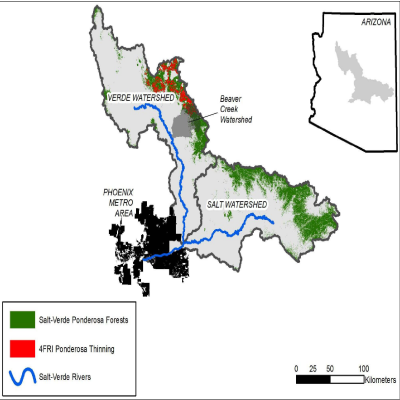
 Thinning of southwestern forests, partly to curb devastating forest fires, has long been a controversial subject. In general, forest thinning has been opposed by environmental groups.
Thinning of southwestern forests, partly to curb devastating forest fires, has long been a controversial subject. In general, forest thinning has been opposed by environmental groups.
Now, however, a new study (“Effects of Climate Variability and Accelerated Forest Thinning on Watershed-Scale Runoff in Southwestern USA Ponderosa Pine Forests” published October 22, 2014) conducted by The Nature Conservancy and Northern Arizona University recommends accelerated forest thinning by mechanical means and controlled burns in central and northern Arizona forests. The study estimates that such thinning will increase runoff by about 20 percent, add to our water supply, and make forests more resilient. You can read the entire study here.
The study abstract reads:
The recent mortality of up to 20% of forests and woodlands in the southwestern United States, along with declining stream flows and projected future water shortages, heightens the need to understand how management practices can enhance forest resilience and functioning under unprecedented scales of drought and wildfire. To address this challenge, a combination of mechanical thinning and fire treatments are planned for 238,000 hectares (588,000 acres) of ponderosa pine (Pinus ponderosa) forests across central Arizona, USA. Mechanical thinning can increase runoff at fine scales, as well as reduce fire risk and tree water stress during drought, but the effects of this practice have not been studied at scales commensurate with recent forest disturbances or under a highly variable climate. Modifying a historical runoff model, we constructed scenarios to estimate increases in runoff from thinning ponderosa pine at the landscape and watershed scales based on driving variables: pace, extent and intensity of forest treatments and variability in winter precipitation. We found that runoff on thinned forests was about 20% greater than unthinned forests, regardless of whether treatments occurred in a drought or pluvial period. The magnitude of this increase is similar to observed declines in snowpack for the region, suggesting that accelerated thinning may lessen runoff losses due to warming effects. Gains in runoff were temporary (six years after treatment) and modest when compared to mean annual runoff from the study watersheds (0–3%). Nonetheless gains observed during drought periods could play a role in augmenting river flows on a seasonal basis, improving conditions for water-dependent natural resources, as well as benefit water supplies for downstream communities. Results of this study and others suggest that accelerated forest thinning at large scales could improve the water balance and resilience of forests and sustain the ecosystem services they provide.
The study also notes that in “ponderosa pine forests of central Arizona, stand densities range from 2 to 44 times greater than during pre-settlement conditions” and all that extra foliage sucks up water and loses it through evapotranspiration, thereby decreasing the availability of water for downstream users and wildlife.
Congress has authorized a program called the Four Forest Restoration Initiative (4FRI) that will accelerate the use of mechanical thinning and prescribed burns across four national forests, treating 238,000 ha (588,000 acres) in the first analysis area over the next 10 years. That program should be expanded.
